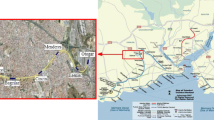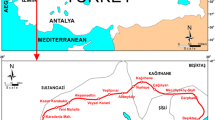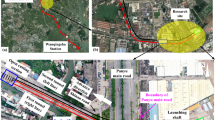Abstract
In metro tunnel excavations, it is important to control surface settlements observed before and after excavation, which may cause damage to surface structures. Otherwise, the metro tunnel cannot perform the task expected, and the advantages of the tunnel are lost. In this study, short-term surface settlements and their effect on buildings are examined in three zones for twin tunnels, which have been excavated between the Otogar and Kirazlı 1 stations of the Istanbul Metro line, and are 5.8 km in length. Geology in the study area is composed of fill, stiff clay, dense sand, very dense sand, and hard clay, respectively, starting from the surface. Tunnels are excavated by using two Earth Pressure Balance Tunnel Boring Machines (EPBMs) with a 6.5 m diameter as twin tubes with 14 m distance from center to center. The EPBM in the right tube is followed about 100 m behind the other tube. Segmental lining with 1.4 m of length is currently employed as final support. The results of this study indicate that, with EPBM excavation method in shallow depths and soft grounds, the damage done to the environment prolonged project costs up to 15.8% more. In addition, tunnel conditions prolonged the project schedule to 29.3%.






Similar content being viewed by others
References
Arioglu E (1992) Surface movements due to tunnelling activities in urban areas and minimization of building damages, Short Course, Istanbul Technical University, Mining Eng Dept (in Turkish)
Attewell PB, Yeates J, Selby AR (1986) Soil movement induced by tunneling and their effects on pipelines and structures. Chapman and Hall, New York, p 325
Ayson Drill Research and Build. AS (2005) Otogar-Bagcılar Station Geological Geotechnical Report. (in Turkish)
Ellis D (2005) High standards in Heatrow’s art. Tunnels and Tunnelling International, September, pp 29–34
Karakus M, Fowell RJ (2003) Effects of different tunnel face advance excavation on the settlement by FEM. Tunn Undergr Space Technol 18:513–523
Minguez F, Gregory A, Guglielmetti V (2005) Best practice in EPB management, Tunnels and Tunnelling International, November, pp 21–25
O’Reilly MP, New BM (1982) Settlement above tunnels in the United Kingdom, their magnitude and prediction, Proceedings of the tunneling 82 conference, Brighton, pp 173–181
Ocak I (2008) Control of surface settlements with umbrella arch method in second stage excavations of Istanbul Metro. Tunn Undergr Space Technol 23:674–681
Suwansawat S, Einstein HH (2006) Artificial neural networks for predicting the maximum surface settlement caused by EPB shield tunnelling. Tunn Undergr Space Technol 21:133–150
Tan WL, Ranjit PG (2003) Parameters and considerations in soft ground tunnelling, Electron J Geotech Eng, pp 344
Author information
Authors and Affiliations
Corresponding author
Rights and permissions
About this article
Cite this article
Ocak, I. Environmental effects of tunnel excavation in soft and shallow ground with EPBM: the case of Istanbul. Environ Earth Sci 59, 347–352 (2009). https://doi.org/10.1007/s12665-009-0032-6
Received:
Accepted:
Published:
Issue Date:
DOI: https://doi.org/10.1007/s12665-009-0032-6




